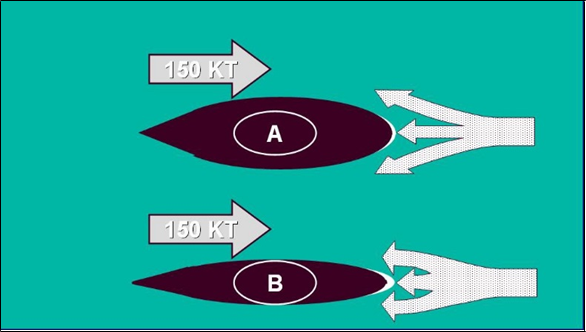Aviation - Hazards - Icing

Icing
Icing occurs if precipitation aggregates on the aircraft or at or within parts of it. There are several impact mechanisms. The dominant mechanism occurs when supercooled liquid water impinges on the aircraft and freezes instantaneously.
Icing may occur:
- inflight or at the surface; or
- ground icing.
One might also categorize icing into:
- airframe icing; and engine icing.
Normally, forecasts of icing are for airframe icing only.
There are three strategies to cope with aircraft icing: (i) aircraft must be certified for icing, (ii) aircraft have to be cleaned of ice prior to take-off (clean wing principle), (iii) aircraft are equipped with de-icing equipment. Each aircraft is certified up to a certain category of icing severity: light, moderate, severe.
Airframe Icing
Airframe icing normally occurs when the ambient air temperature is below 0° C and supercooled water droplets are present. However, icing may occur even when the outside air temperature is well above 0°C: when an aircraft descends quickly from a high altitude, the aircraft skin, especially close to the tanks, may still be below freezing point (known as ‘cold soak’).
There are several types of airframe icing:
- Rime Ice – white, porous, opaque, brittle and rough, so disruptive to airflow. This occurs at low temperatures (< -10°C) and/or low liquid water contents, as under those circumstances the released heat during the freezing process can be transported immediately to the environment.
- Clear Ice (also known as glaze ice) – clear, tough, adhesive, dense and heavy, smooth, so little effect on airflow. It occurs usually at warmer temperatures (> -10°C) and/or high liquid water contents as then, during the freezing process, an ice/water mixture is formed which remains semiliquid for several seconds. Due to the relatively warm temperatures the released heat needs a longer time to be carried away by the ambient air flow.
- SLD (supercooled large drops or drizzle drops) with diameters ranging between 50 and 500 µm. SLD may flow after impingement behind the protected zones on the wing and freeze there. Certification regulations in the past ignored this hazard, and meteorologists are requested to carefully forecast SLD (freezing drizzle).
- Mixed Ice – impingement of supercooled water and ice.
- Freezing Rain - if supercooled rain drops with diameter larger than 500 µm hit the aircraft, extreme accretion of ice may occur.
- Hoar frost – thin ‘coating’ occurring in the absence of rain or cloud usually when aircraft is parked outside on cold winter nights.
- Snow accreted on the fuselage - has to be removed prior to take-off.
- Rain and snow mixed (sleet) is similar to freezing rain and can also lead to ‘pack snow’ that can block air intakes and other aircraft openings.

Small supercooled cloud droplets freeze rapidly on contact with the aircraft, trapping in the ice to give a deposit of white rime on forward-facing surfaces. Larger droplets take longer to freeze, spreading out across the airframe before solidifying.
The intensity of icing is defined as follows:
- Light: Accumulation rate may create a problem if flight in this environment exceeds 1 hour.
- Moderate: Rate of accumulation is such that even short encounters are potentially hazardous. Anti-icing equipment must be used.
- Severe: Rate of accumulation is such that use of anti-icing equipment fails to reduce or control the hazard. Immediate diversion from the region is necessary.
Aside from meteorological factors, the rate of ice build-up on the airframe also depends on the characteristics of the aircraft. Fast aircraft with thin wing cross-sections are more susceptible to deteriorating aerodynamics, and hence are more susceptible to ice accretion.
Helicopters are particularly vulnerable to icing, since build-up of ice on the rotors can lead to imbalance, destabilising the aircraft.

Airframe icing is a serious aviation hazard. The possible range of effects on an aircraft are listed below:
- Reduction in the aerodynamic properties.
- Change in flight performance.
- Increase in weight and uneven loading.
- Engine intakes become blocked.
- Undercarriage retraction/extension problems.
- Control surfaces jam or become stiff.
- Pitot tubes become blocked.
- Communications affected.
- Vision impaired.
Engine or piston icing occurs under conditions of high relative humidity close to freezing when the under pressure in a piston causes the humidity to condense and freeze within the engine.
Engine Icing
Some aircraft are prone to icing in the carburettor and air intakes. This is caused by a reduction in pressure leading to adiabatic cooling as the air expands.
Carburettor icing is by far the most common form of ice-related problem affecting piston-engined aircraft. When humid air enters the venturi in the carburettor, ice crystals are deposited. This constricts the venturi and causes progressive power reduction. Carburettor icing frequently occurs when the ambient air temperature is above 0° C, the dominant factor being the moisture content of the air. The more humid the air, the higher the risk; hence engine icing is more likely on a warm, humid, cloudy summer’s day than on a cold, dry, clear winter’s day. In very moist air, adiabatic cooling can result in a temperature reduction of up to 5° C.
The cooling may be enhanced in the carburettor by the evaporation of fuel. This refrigeration cooling can in itself lead to a temperature reduction of around 10° C.
An additional problem for the engine is the buildup of ice on the rims and struts of intakes. In extreme cases, large pieces of ice can break off and cause damage to the engine.
Some aircraft may require forecasts of the heights of specified temperatures (e.g. the PS 03 and MS 01 levels) to avoid flying at heights where engine icing may be a problem.
Engine icing is most common when the air temperature is a few degrees above 0° C and the relative humidity is greater than 60%. Pilots, therefore, use forecast temperature data and an estimate of humidity to assess the engine icing risk. Typical high humidity scenarios are mist after heavy rain, and just below stratiform cloud.
CLICK HERE to return to our homepage
